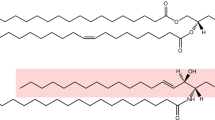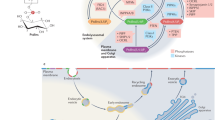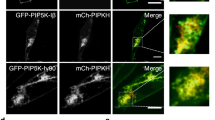Abstract
The plasma membrane delimits the cell and controls material and information exchange between itself and the environment. How different plasma-membrane processes are coordinated and how the relative abundance of plasma-membrane lipids and proteins is homeostatically maintained are not yet understood. Here, we used a quantitative genetic interaction map, or E-MAP, to functionally interrogate a set of ∼400 genes involved in various aspects of plasma-membrane biology, including endocytosis, signaling, lipid metabolism and eisosome function. From this E-MAP, we derived a set of 57,799 individual interactions between genes functioning in these various processes. Using triplet genetic motif analysis, we identified a new component of the eisosome, Eis1, and linked the poorly characterized gene EMP70 to endocytic and eisosome function. Finally, we implicated Rom2, a GDP/GTP exchange factor for Rho1 and Rho2, in the regulation of sphingolipid metabolism.
This is a preview of subscription content, access via your institution
Access options
Subscribe to this journal
Receive 12 print issues and online access
$189.00 per year
only $15.75 per issue
Buy this article
- Purchase on Springer Link
- Instant access to full article PDF
Prices may be subject to local taxes which are calculated during checkout








Similar content being viewed by others
References
Grossmann, G., Opekarova, M., Malinsky, J., Weig-Meckl, I. & Tanner, W. Membrane potential governs lateral segregation of plasma membrane proteins and lipids in yeast. EMBO J. 26, 1–8 (2007).
Walther, T.C. et al. Eisosomes mark static sites of endocytosis. Nature 439, 998–1003 (2006).
Grossmann, G. et al. Plasma membrane microdomains regulate turnover of transport proteins in yeast. J. Cell Biol. 183, 1075–1088 (2008).
deHart, A.K., Schnell, J.D., Allen, D.A. & Hicke, L. The conserved Pkh-Ypk kinase cascade is required for endocytosis in yeast. J. Cell Biol. 156, 241–248 (2002).
Friant, S., Lombardi, R., Schmelzle, T., Hall, M.N. & Riezman, H. Sphingoid base signaling via Pkh kinases is required for endocytosis in yeast. EMBO J. 20, 6783–6792 (2001).
Walther, T.C. et al. Pkh-kinases control eisosome assembly and organization. EMBO J. 26, 4946–4955 (2007).
Aronova, S. et al. Regulation of ceramide biosynthesis by TOR complex 2. Cell Metab. 7, 148–158 (2008).
Guan, X.L. et al. Functional interactions between sphingolipids and sterols in biological membranes regulating cell physiology. Mol. Biol. Cell 20, 2083–2095 (2009).
Tabuchi, M., Audhya, A., Parsons, A.B., Boone, C. & Emr, S.D. The phosphatidylinositol 4,5-biphosphate and TORC2 binding proteins Slm1 and Slm2 function in sphingolipid regulation. Mol. Cell. Biol. 26, 5861–5875 (2006).
Tong, A.H. et al. Global mapping of the yeast genetic interaction network. Science 303, 808–813 (2004).
Schuldiner, M. et al. Exploration of the function and organization of the yeast early secretory pathway through an epistatic miniarray profile. Cell 123, 507–519 (2005).
Collins, S.R., Schuldiner, M., Krogan, N.J. & Weissman, J.S. A strategy for extracting and analyzing large-scale quantitative epistatic interaction data. Genome Biol. 7, R63 (2006).
Schuldiner, M., Collins, S.R., Weissman, J.S. & Krogan, N.J. Quantitative genetic analysis in Saccharomyces cerevisiae using epistatic miniarray profiles (E-MAPs) and its application to chromatin functions. Methods 40, 344–352 (2006).
Ulitsky, I., Shlomi, T., Kupiec, M. & Shamir, R. From E-MAPs to module maps: dissecting quantitative genetic interactions using physical interactions. Mol. Syst. Biol. 4, 209 (2008).
Bandyopadhyay, S., Kelley, R., Krogan, N.J. & Ideker, T. Functional maps of protein complexes from quantitative genetic interaction data. PLOS Comput. Biol. 4, e1000065 (2008).
Collins, S.R. et al. Functional dissection of protein complexes involved in yeast chromosome biology using a genetic interaction map. Nature 446, 806–810 (2007).
Fiedler, D. et al. Functional organization of the S. cerevisiae phosphorylation network. Cell 136, 952–963 (2009).
Wilmes, G.M. et al. A genetic interaction map of RNA-processing factors reveals links between Sem1/Dss1-containing complexes and mRNA export and splicing. Mol. Cell 32, 735–746 (2008).
Collins, S.R. et al. Toward a comprehensive atlas of the physical interactome of Saccharomyces cerevisiae. Mol. Cell. Proteomics 6, 439–450 (2007).
Gavin, A.C. et al. Proteome survey reveals modularity of the yeast cell machinery. Nature 440, 631–636 (2006).
Krogan, N.J. et al. Global landscape of protein complexes in the yeast Saccharomyces cerevisiae. Nature 440, 637–643 (2006).
Ren, G., Vajjhala, P., Lee, J.S., Winsor, B. & Munn, A.L. The BAR domain proteins: molding membranes in fission, fusion, and phagy. Microbiol. Mol. Biol. Rev. 70, 37–120 (2006).
Revardel, E., Bonneau, M., Durrens, P. & Aigle, M. Characterization of a new gene family developing pleiotropic phenotypes upon mutation in Saccharomyces cerevisiae. Biochim. Biophys. Acta 1263, 261–265 (1995).
Breton, A.M. & Aigle, M. Genetic and functional relationship between Rvsp, myosin and actin in Saccharomyces cerevisiae. Curr. Genet. 34, 280–286 (1998).
Brizzio, V., Gammie, A.E. & Rose, M.D. Rvs161p interacts with Fus2p to promote cell fusion in Saccharomyces cerevisiae. J. Cell Biol. 141, 567–584 (1998).
Friesen, H. et al. Characterization of the yeast amphiphysins Rvs161p and Rvs167p reveals roles for the Rvs heterodimer in vivo. Mol. Biol. Cell 17, 1306–1321 (2006).
Jonikas, M.C. et al. Comprehensive characterization of genes required for protein folding in the endoplasmic reticulum. Science 323, 1693–1697 (2009).
Valdivia, R.H., Baggott, D., Chuang, J.S. & Schekman, R.W. The yeast clathrin adaptor protein complex 1 is required for the efficient retention of a subset of late Golgi membrane proteins. Dev. Cell 2, 283–294 (2002).
Efe, J.A. et al. Yeast Mon2p is a highly conserved protein that functions in the cytoplasm-to-vacuole transport pathway and is required for Golgi homeostasis. J. Cell Sci. 118, 4751–4764 (2005).
Levin, D.E. Cell wall integrity signaling in Saccharomyces cerevisiae. Microbiol. Mol. Biol. Rev. 69, 262–291 (2005).
Frohlich, F. et al. A genome-wide screen for genes affecting eisosomes reveals Nce102 function in sphingolipid signaling. J. Cell Biol. 185, 1227–1242 (2009).
Ong, S.E. et al. Stable isotope labeling by amino acids in cell culture, SILAC, as a simple and accurate approach to expression proteomics. Mol. Cell. Proteomics 1, 376–386 (2002).
Wang, H. et al. A complex-based reconstruction of the Saccharomyces cerevisiae interactome. Mol. Cell. Proteomics 8, 1361–1381 (2009).
Deng, C., Xiong, X. & Krutchinsky, A.N. Unifying fluorescence microscopy and mass spectrometry for studying protein complexes in cells. Mol. Cell. Proteomics 8, 1413–1423 (2009).
Schimmoller, F., Diaz, E., Muhlbauer, B. & Pfeffer, S.R. Characterization of a 76 kDa endosomal, multispanning membrane protein that is highly conserved throughout evolution. Gene 216, 311–318 (1998).
Vida, T.A. & Emr, S.D. A new vital stain for visualizing vacuolar membrane dynamics and endocytosis in yeast. J. Cell Biol. 128, 779–792 (1995).
Zheng, B., Wu, J.N., Schober, W., Lewis, D.E. & Vida, T. Isolation of yeast mutants defective for localization of vacuolar vital dyes. Proc. Natl. Acad. Sci. USA 95, 11721–11726 (1998).
Babst, M., Wendland, B., Estepa, E.J. & Emr, S.D. The Vps4p AAA ATPase regulates membrane association of a Vps protein complex required for normal endosome function. EMBO J. 17, 2982–2993 (1998).
Teis, D., Saksena, S. & Emr, S.D. Ordered assembly of the ESCRT-III complex on endosomes is required to sequester cargo during MVB formation. Dev. Cell 15, 578–589 (2008).
Brickner, J.H. & Fuller, R.S. SOI1 encodes a novel, conserved protein that promotes TGN-endosomal cycling of Kex2p and other membrane proteins by modulating the function of two TGN localization signals. J. Cell Biol. 139, 23–36 (1997).
Sipos, G. et al. Soi3p/Rav1p functions at the early endosome to regulate endocytic trafficking to the vacuole and localization of trans-Golgi network transmembrane proteins. Mol. Biol. Cell 15, 3196–3209 (2004).
Robinson, J.S., Klionsky, D.J., Banta, L.M. & Emr, S.D. Protein sorting in Saccharomyces cerevisiae: isolation of mutants defective in the delivery and processing of multiple vacuolar hydrolases. Mol. Cell. Biol. 8, 4936–4948 (1988).
Rothman, J.H., Howald, I. & Stevens, T.H. Characterization of genes required for protein sorting and vacuolar function in the yeast Saccharomyces cerevisiae. EMBO J. 8, 2057–2065 (1989).
Cerantola, V. et al. Aureobasidin A arrests growth of yeast cells through both ceramide intoxication and deprivation of essential inositolphosphorylceramides. Mol. Microbiol. 71, 1523–1537 (2009).
Ejsing, C.S. et al. Global analysis of the yeast lipidome by quantitative shotgun mass spectrometry. Proc. Natl. Acad. Sci. USA 106, 2136–2141 (2009).
Schmidt, A., Bickle, M., Beck, T. & Hall, M.N. The yeast phosphatidylinositol kinase homolog TOR2 activates RHO1 and RHO2 via the exchange factor ROM2. Cell 88, 531–542 (1997).
Kobayashi, T., Takematsu, H., Yamaji, T., Hiramoto, S. & Kozutsumi, Y. Disturbance of sphingolipid biosynthesis abrogates the signaling of Mss4, phosphatidylinositol-4-phosphate 5-kinase, in yeast. J. Biol. Chem. 280, 18087–18094 (2005).
Audhya, A. & Emr, S.D. Stt4 PI 4-kinase localizes to the plasma membrane and functions in the Pkc1-mediated MAP kinase cascade. Dev. Cell 2, 593–605 (2002).
Cherry, J.M. et al. SGD: Saccharomyces Genome Database. Nucleic Acids Res. 26, 73–79 (1998).
Kanehisa, M. & Goto, S. KEGG: Kyoto encyclopedia of genes and genomes. Nucleic Acids Res. 28, 27–30 (2000).
Reguly, T. et al. Comprehensive curation and analysis of global interaction networks in Saccharomyces cerevisiae. J. Biol. 5, 11 (2006).
Janke, C. et al. A versatile toolbox for PCR-based tagging of yeast genes: new fluorescent proteins, more markers and promoter substitution cassettes. Yeast 21, 947–962 (2004).
Mullins, C. & Bonifacino, J.S. Structural requirements for function of yeast GGAs in vacuolar protein sorting, α-factor maturation, and interactions with clathrin. Mol. Cell. Biol. 21, 7981–7994 (2001).
Olsen, J.V. et al. Parts per million mass accuracy on an Orbitrap mass spectrometer via lock mass injection into a C-trap. Mol. Cell. Proteomics 4, 2010–2021 (2005).
Cox, J. & Mann, M. MaxQuant enables high peptide identification rates, individualized p.p.b.-range mass accuracies and proteome-wide protein quantification. Nat. Biotechnol. 26, 1367–1372 (2008).
Moore, R.E., Young, M.K. & Lee, T.D. Qscore: an algorithm for evaluating SEQUEST database search results. J. Am. Soc. Mass Spectrom. 13, 378–386 (2002).
Peng, J., Elias, J.E., Thoreen, C.C., Licklider, L.J. & Gygi, S.P. Evaluation of multidimensional chromatography coupled with tandem mass spectrometry (LC/LC-MS/MS) for large-scale protein analysis: the yeast proteome. J. Proteome Res. 2, 43–50 (2003).
Perkins, D.N., Pappin, D.J., Creasy, D.M. & Cottrell, J.S. Probability-based protein identification by searching sequence databases using mass spectrometry data. Electrophoresis 20, 3551–3567 (1999).
Acknowledgements
We thank members of the Walther and Krogan laboratory for critical reading and comments, J. Brickner for suggestions, Ulrike Laabs for excellent technical assistance, O. Nørregaard Jensen (University of Southern Denmark) for providing access to the Nanomate Triversa used for the lipidomic experiments and P. Kemmeren for establishing the database. This work was supported by the Max Planck Society (T.C.W.), the German Research Foundation (DFG; T.C.W.), the German-Israeli Foundation (T.C.W.), the US National Institutes of Health, the Searle, Sandler and Keck Foundations (N.J.K.), the International Human Frontier Science Program (HFSP; T.C.W.), the Israel Science Foundation (grant no. 802/08; R.S.), the Edmond J. Safra Bioinformatics program at Tel Aviv University (I.U.), the Programa de Apoyo Sectorial a la Estrategia Nacional de Innovación (INNOVA URUGUAY, DCI-ALA/2007/19.040, P.S.A.), the Agencia Nacional de Investigación e Innovación (ANII, A.O.-C.), the Danish Council for Independent Research (DOK1155860, C.S.E.) and Lundbeckfonden (R45-A4342, C.S.E.).
Author information
Authors and Affiliations
Contributions
All authors contributed to every aspect of this work.
Corresponding authors
Ethics declarations
Competing interests
The authors declare no competing financial interests.
Supplementary information
Supplementary Text and Figures
Supplementary Figures 1–5, Supplementary Tables 3–7 (PDF 10198 kb)
Supplementary Table 1
Classification of genes used for Figure 1a (XLS 67 kb)
Supplementary Table 2
Correlations of genes pairs in the plasma membrane E-MAP used in Figures 1b and 1c. (XLS 12860 kb)
Supplementary Video 1
Localization of Emp70-GFP. (AVI 11923 kb)
Supplementary Video 2
Localization of Emp70-GFP in respect to Lsp1-RFPmars. (AVI 11887 kb)
Supplementary Data
Treeview representation for clustergram of the PM E-MAP, composed of 4 files (.atr, .cdt,.gtr.,jtv). These files can be opened by a treeview program such as Java Treeview that can be found at: http://jtreeview.sourceforge.net/. (ZIP 471 kb)
Rights and permissions
About this article
Cite this article
Aguilar, P., Fröhlich, F., Rehman, M. et al. A plasma-membrane E-MAP reveals links of the eisosome with sphingolipid metabolism and endosomal trafficking. Nat Struct Mol Biol 17, 901–908 (2010). https://doi.org/10.1038/nsmb.1829
Received:
Accepted:
Published:
Issue Date:
DOI: https://doi.org/10.1038/nsmb.1829
This article is cited by
-
Heterologous mammalian Akt disrupts plasma membrane homeostasis by taking over TORC2 signaling in Saccharomyces cerevisiae
Scientific Reports (2018)
-
Genetic interaction mapping in mammalian cells using CRISPR interference
Nature Methods (2017)
-
Plasma membrane organization promotes virulence of the human fungal pathogen Candida albicans
Journal of Microbiology (2016)
-
The systematic analysis of protein–lipid interactions comes of age
Nature Reviews Molecular Cell Biology (2015)
-
TORC2 and eisosomes are spatially interdependent, requiring optimal level of phosphatidylinositol 4, 5-bisphosphate for their integrity
Journal of Biosciences (2015)



